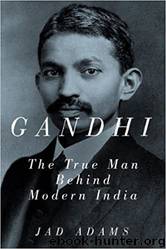Gandhi: The True Man Behind Modern India by Jad Adams

Author:Jad Adams [Adams, Jad]
Language: eng
Format: epub
ISBN: 9781681770109
Publisher: Pegasus
Published: 2011-10-14T16:00:00+00:00
8
The Salt March
TO YERAVDA JAIL in Poona Gandhi took a few books such as the Bhagavad Gita, a dictionary, a translation of the Koran and a Bible. He also took his spinning-wheel to which he had become increasingly attached, listening to its whirr as to a mantra, but it was taken away by his jailers. He said he would fast if he could not spin, and it was restored. On the first night in jail he said to Shankerlal Banker, the editor of Young India who had been imprisoned with him: ‘Take God’s name and go to sleep. The best way to overcome all difficulties is to recite Ramanama.’1
‘At last I am having a quiet time,’ he wrote to Charles Andrews from his ten-foot-square cell.2 He would rise at 4 a.m. and go to bed at 10 p.m., filling the day with activity; he devoted six hours a day to reading history, biography, theology and even some of Kipling’s verse. It was here that he wrote Satyagraha in South Africa and published it serially in Young India, dictating it to his devoted cousin and disciple Maganlal Gandhi. He would spin and do related tasks for four or more hours and walk outside for an hour in the morning and half an hour in the evening; if it were raining he would walk around his cell. At dawn and at sunset he said prayers, recited texts and sang devotional songs. He devoted an hour a day to teaching Sanskrit to Shankerlal, who appointed himself Gandhi’s servant; he massaged his master’s head and feet in the evening before bed, cooked for him, cleaned his cell and washed his clothes. Gandhi later took to performing these last two tasks himself as he felt he could get the cell cleaner and use less soap when washing clothes than his friend. Shankerlal referred to other specifics of caring for Gandhi: his master would count the match-sticks in the match-box and work out how many should last for exactly seven days, and he insisted on exactly a hundred currants for breakfast and that the pieces of bread served to him should be of equal size.3
Intermittently Gandhi was suffering severe abdominal pains which intensified at the beginning of January 1924, and he was removed to Sassoon Hospital, Poona, under Colonel Maddock, the surgeon general of the area. On 12 January he was operated on for appendicitis. Although released unconditionally on 5 February, he stayed in hospital for another month, recovering his strength. In a typically Gandhian gesture he resolved not to attack the Empire until his six-year sentence was up in March 1928, thereby respecting the spirit of his term of imprisonment.
He used some of his time for literary activities: he resumed the editorship of Young India and Navajivan and published his two autobiographical pieces serially, first Satyagraha in South Africa and then, from 1925, An Autobiography or The Story of my Experiments with Truth. From 1926 he published his discourses on the Bhagavad Gita.
On the political front, Congress was in some disarray after Gandhi’s departure.
Download
This site does not store any files on its server. We only index and link to content provided by other sites. Please contact the content providers to delete copyright contents if any and email us, we'll remove relevant links or contents immediately.
| Chakras | Gandhi |
| History | Rituals & Practice |
| Sacred Writings | Sutras |
| Theology |
Fingersmith by Sarah Waters(2481)
Kundalini by Gopi Krishna(2135)
Wheels of Life by Anodea Judith(2092)
Indian Mythology by Devdutt Pattanaik(1896)
The Bhagavad Gita by Bibek Debroy(1896)
The Yoga of Jesus: Understanding the Hidden Teachings of the Gospels by Paramahansa Yogananda(1803)
Autobiography of a Yogi (Complete Edition) by Yogananda Paramahansa(1774)
The Man from the Egg by Sudha Murty(1741)
The Book of Secrets: 112 Meditations to Discover the Mystery Within by Osho(1628)
Chakra Mantra Magick by Kadmon Baal(1615)
The Sparsholt Affair by Alan Hollinghurst(1542)
Sparks of Divinity by B. K. S. Iyengar(1491)
Avatar of Night by Tal Brooke(1484)
Gandhi by Ramachandra Guha(1484)
Karma-Yoga and Bhakti-Yoga by Swami Vivekananda(1467)
The Bhagavad Gita (Classics of Indian Spirituality) by Eknath Easwaran(1452)
The Spiritual Teaching of Ramana Maharshi by Ramana Maharshi(1401)
Hinduism: A Very Short Introduction (Very Short Introductions) by Knott Kim(1344)
Skanda Purana (Great Epics of India: Puranas Book 13) by Bibek Debroy & Dipavali Debroy(1338)
